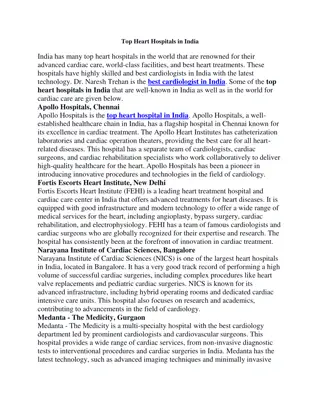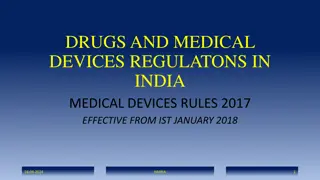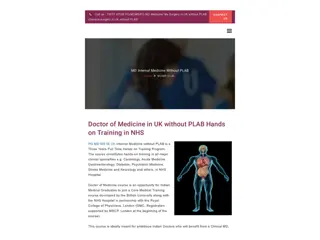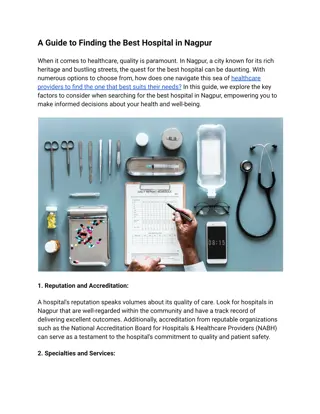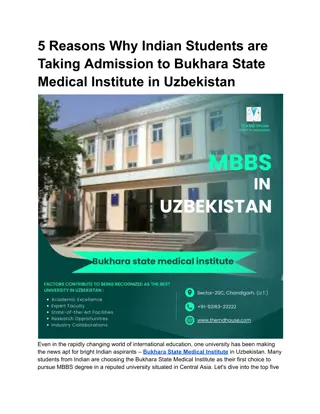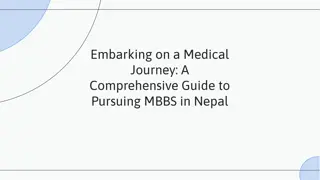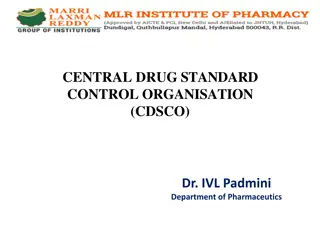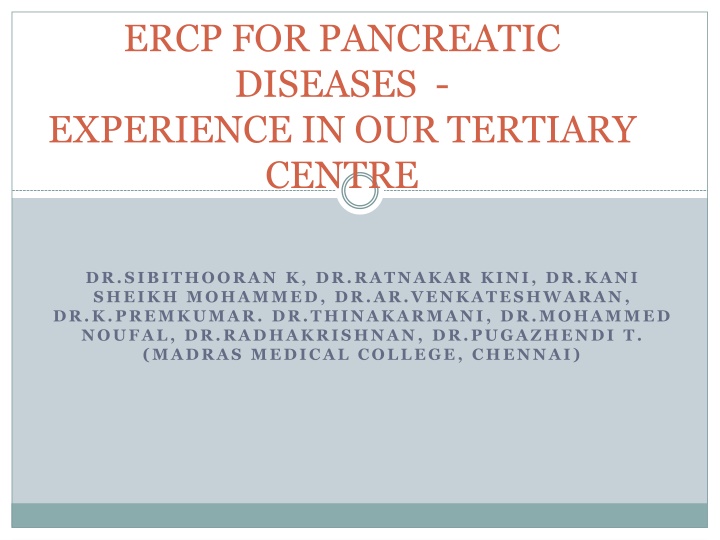
ERCP for Pancreatic Diseases: Experience and Insights
Explore the evolution of ERCP from a diagnostic to a therapeutic procedure for pancreatic diseases such as recurrent acute pancreatitis and chronic pancreatitis. Learn about the successful application of endoscopic therapy for managing pancreatic disorders in a tertiary center in Chennai. See how ductal decompression plays a crucial role in alleviating pain and inflammation in chronic pancreatitis cases.
Download Presentation

Please find below an Image/Link to download the presentation.
The content on the website is provided AS IS for your information and personal use only. It may not be sold, licensed, or shared on other websites without obtaining consent from the author. If you encounter any issues during the download, it is possible that the publisher has removed the file from their server.
You are allowed to download the files provided on this website for personal or commercial use, subject to the condition that they are used lawfully. All files are the property of their respective owners.
The content on the website is provided AS IS for your information and personal use only. It may not be sold, licensed, or shared on other websites without obtaining consent from the author.
E N D
Presentation Transcript
ERCP FOR PANCREATIC DISEASES - EXPERIENCE IN OUR TERTIARY CENTRE DR.SIBITHOORAN K, DR.RATNAKAR KINI, DR.KANI SHEIKH MOHAMMED, DR.AR.VENKATESHWARAN, DR.K.PREMKUMAR. DR.THINAKARMANI, DR.MOHAMMED NOUFAL, DR.RADHAKRISHNAN, DR.PUGAZHENDI T. (MADRAS MEDICAL COLLEGE, CHENNAI)
INTRODUCTION ERCP was originally developed almost half a century ago as a diagnostic tool for pancreatico biliary disorder1,2 With the development of non invasive and minimally invasive diagnostic alternatives such as magnetic resonance cholangiopancreatography (MRCP) and endoscopic ultra sound, ERCP has evolved from primarily a diagnostic modality to almost an entirely therapeutic procedure.
RECURRENT ACUTE PANCREATITIS Patients with recurrent acute pancreatitis are prone to develop chronic pancreatitis and the management options are limited3. Endoscopic therapy in the form of papillary sphincterotomy with or without pancreatic ductal stenting is useful in cases of pancreatic divisum , idiopathic RAP or smoldering AP. Also in cases of acute pancreatitis complicated by fluid collections or fistulae endotherapy has a major role to play.
CHRONIC PANCREATITIS In chronic pancreatitis evidence that ductal hypertension can result in inflammation and pain justifies the ductal decompression for amelioration of pain. Decompression with endoscopic approach is currently recommended as the first line modality by european society of gastrointestinal endoscopy(ESGE)4.
AIM To assess the success rates of Pancreatic ductal stenting with respect to indications.
MATERIALS AND METHODS : Venue : Institute of Medical gastroenterology, Madras medical college Duration : August 2015 to july 2017 Excluding patients who underwent biliary stenting for biliary pancreatitis all the other patients for whom ERCP was done for pancreatic diseases were included.
STUDY POPULATION, MATERIALS AND METHODS 83 Patients met the study criteria 49 were males and 34 were females Outcomes were dichotomously categorized into success or failure SEX MALES FEMAL ES
STATISTICAL ANALYSIS The success rates with respect to individual indications of endotherapy were analysed using the logistic regression method using the software SPSS and the results were obtained.
INDICATIONS 35 30 25 20 15 10 5 0 PSEUDOCYST CCP PD LEAK DIVISUM TRAUMATIC
RESULTS SYMPTOMATIC PANCREATIC PSEUDOCYST 21 patients underwent ERCP for pseudocyst. In 6 (29%)patients nothing more than transpapillary PD stenting was required . Where as in the other 15(71%) the stenting was not possible technically or patient required other forms of therapy in the form of percutaneous or endoscopic transmural drainage or surgery. The success of the procedure largely depended on the communication of the pancreatic duct with the cyst .
Pseudocyst pseudocyst 15 10 5 pseudocyst 0 pseudocyst success failure
RESULTS CHRONIC PANCREATITIS : In 32 patients PD stenting was attempted for chronic calcific pancreatitis with persistent symptoms and had significant strictures and / or calculi on imaging. 9 patients did not require anything more than trans papillary PD stenting (28%) . Rest of the 23 patients (72%) who had persistent symptoms following the procedure were suggested surgical management.
CHRONIC PANCREATITIS CCP 30 20 10 CCP 0 CCP SUCCESS FAILURE
RESULTS FISTULA WITH ASCITES OR PLEURAL EFFUSION 12 patients underwent PD stenting for this problem. 4(33%) of them responded very well. Other 8 did not(66%)
PD FISTULA PD FISTULA 8 6 4 PD FISTULA 2 0 PD FISTULA SUCCESS FAILURE
RESULTS RECURRENT ACUTE PANCREATITIS OR CHRONIC PANCREATITIS DUE TO PANCREAS DIVISUM : 11 patients were treated for pancreatic divisum with papillary sphincterotomy and PD stenting. 10 (91%) patients did not require anything more. This was statistically significant with a P value of 0.005.
PANCREAS DIVISUM DIVISUM 10 5 DIVISUM 0 DIVISUM SUCCESS FAILURE
RESULTS TRAUMATIC PANCREATITS : 7 patients with partial PD injury after a blunt abdominal trauma who developed acute pancreatitis were taken up for PD stenting. Was successfully accomplished in 6 (85%). This was statistically significant with a P value of 0.01.
TRAUMATIC PANCREATITIS TRUMATIC PANCREATITIS 6 4 TRUMATIC PANCREATITIS 2 0 TRUMATIC PANCREATITIS SUCCESS FAILURE
SUMMARY 25 20 15 10 SUCCESS FAILURE 5 0
DISCUSSION Pancreatic endotherapy is being increasingly used for treatment of variety of pancreatic disorders including -Chronic pancreatitis -Idiopathic recurrent acute pancreatitis -Pancreatic duct leaks or disruptions, -Drainage of pseudocysts -Prevention of of pancreatitis following ERCP.
Pancreas divisum Pancreas divisum is the most common congenital pancreatic anomaly occurring in approximately 7% of of subjects in autopsy series(6,7). More than 95% of patients with pancreatic divisum remain asymptomatic . Dilatation of the dorsal pancreatic duct implies that there is a pathologic narrowing at the minor papilla and the patient might benefit from minor papilla sphincterotomy with or without stenting(8).
TRAUMATIC PANCREATITIS Blunt or penetrating trauma can damage the pancreas , although these injuries are uncommon due to the retroperitoneal location of the gland (9,10). Trauma can range from a mild contusion to a severe crush injury or transaction of the gland ; the later usually occurs at at the point where gland crosses the spine.
TRAUMATIC PANCREATITIS Healing of pancreatic ductal injuries can lead to scarring and stricture of the main pancreatic ductwith resultant obstructive pancreatitis. Hence it becomes important to manage trauma to the PD effectively which can be done by a rather minimally invasive endotherapy in selected cases.
CONCLUSION ERCP is very effective in managing cases of pancreas divisum and traumatic pancreatitis In other cases careful selection of the patients for endotherapy is the major determinant of success In cases of pseudocysts communication with pancreatic duct is the factor which determines the outcome In cases of chronic calcific pancreatitis strictures or calculi near the ampulla in head region are more likely to respond
REFERENCES 1.McCune WS, Shorb PE, Moscovitz H. Endoscopic cannulation of the ampulla of vater: a preliminary report. Ann Surg 1968; 167(5):752-6. 2.Freeman ML, Nelson DB, Sherman S, et al. Same day discharge after endoscopic biliary sphincterotomy: observations from a prospective multicenter complication study. The Multicenter Endoscopic Sphincterotomy (MESH) Study Group. Gastrointestinal Endosc 1999;49(5):580-6. 3.Wehrmann T, Schimitt T, Seifert H. Endoscopic botulinium toxin iinjection into the minor papilla for treatment of idiopathic recurrent pancreatitis in patients with pancreas divisum. Gastrointest Endosc 1999;50(4);545-8. 4.Dumonceau JM, Delhaye M, Tringali A, et al. Endoscopic treatment of chronic pancreatitis : Eueopean society of gastrointestinal endoscopy (ESGE) Clinical Guideline. Endoscopy 2012;44:784-800. 5.Elta GH. Temporary prophylactic pancreatic stents: which patients need them? Gastrointest Endosc 2008; 67:262.
REFERENCES 6.Smanio T. Proposed nomenclature and classification of the huma n pancreatic ducts and duodenal papillae. Study based on 200 post mortems. Int Surg 1969; 52:125. 7.Stimec B, Bulaji M, Korneti V, et al. Ductal morphometry of v entral pancreas in pancreas divisum. Comparison between clinical a nd anatomical results. Ital J Gastroenterol 1996; 28:76. 8.Guelrud M, Mendoza S, Viera L, Gelrud D. Somatostatin prevents acute pancreatitis after pancreatic duct sphincter hydrostatic balloo n dilation in patients with idiopathic recurrent pancreatitis. Gastroi ntest Endosc 1991; 37:44. 9.Wilson RH, Moorehead RJ. Current management of trauma to the pancreas. Br J Surg 1991; 78:1196. 10.Gerson LB, Tokar J, Chiorean M, et al. Complications associated with double balloon enteroscopy at nine US centers. Clin Gastroente rol Hepatol 2009; 7:1177.



